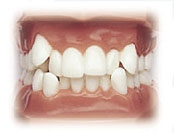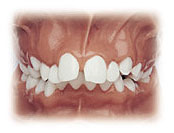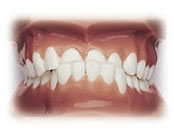What is a Malocclusion?
A malocclusion is an incorrect relationship between the maxilla (upper arch) and the mandible (lower arch), or a general misalignment of the teeth. Malocclusions are so common that most individuals exhibit one, to some degree. Poor alignment of the teeth is thought to be a result of genetic factors combined with poor oral habits, or other factors in the early years.
Moderate malocclusions commonly require treatment by an orthodontist. Orthodontists are dentists who specialize in the treatment of malocclusions and other facial/skeletal irregularities.
The following are three main classifications of malocclusion:
Class I
Class I malocclusion results from the posterior teeth relating in the proper anteroposterior (front to back or horizontal) relationship, but there problems with spacing, overcrowding or width discrepancies of the teeth and jaws”

Class II
Class II malocclusion represents abnormal bite relationships in which the upper jaw
1. read “and teeth project ahead of the lower teeth and jaw. This is known as “overjet” but commonly referred to by patients as “overbite”. Class II patients usually exhibit a convex facial profile with a deficient chin prominence. Typically, a Class II problem is inherited and results in a smaller than normal lower jaw. Other factors, such as persistent thumb sucking, can aggravate these problems. Correction of this disorder can require influencing facial growth to bring the upper and lower jaws and teeth into their proper position.

Class III
Class III problems are primarily genetic in origin. In this instance, the lower jaw and teeth are displaced to the front of the upper jaw structures, which is seen as an underbite. Facially, the appearance may give the impression that the lower jaw is excessively large, but in many cases the lack of upper jaw development can be at fault.

Reasons for treating a malocclusion
There are two categories of malocclusions, dental and skeletal. The moderate malposition of teeth can usually be corrected even with an underlying skeletal disharmony. In more severe cases where the skeletal and dental positions are too significant to correct without adjunctive surgery, the orthodontist may work in combination with an oral maxillofacial surgeon to reharmonize the jaw relationship. It is never too late to seek treatment for a malocclusion. Children and adults alike have completed orthodontic realignment procedures and have been delighted with the resulting even, straight smile. The people around our patients recognize the significant improvement in their smile and facial balance, but our patients will also notice the large improvement in function of their teeth and ability to eat.
Here are some of the main reasons to seek orthodontic treatment for a malocclusion:
· Reduced risk of tooth decay – A malocclusion often causes an uneven wear pattern on the teeth. The constant wearing of the same teeth can lead to tooth erosion and decay.
· Better oral hygiene – A malocclusion can be caused by overcrowding. When too many teeth are competing for too little space, it can be difficult to clean the teeth and gums effectively. It is much easier to clean straight teeth that are properly aligned.
· Reduced risk of TMJ – Temporomandibular jaw syndrome (TMJ) is thought to be related to the malocclusion in some individuals. Headaches, facial pain and grinding teeth during sleep all result from the excessive pressure to the temporomandibular joint. Realigning the teeth may reduce pressure, and eliminates these symptoms.
How is a malocclusion treated?
A malocclusion is usually treated with braces. The orthodontist takes orthodontic records (panoramic x-rays, conducts visual examinations, photos and a digital scan of the teeth and bite) before finalizing the best course of treatment. The recommendation for treatment is based on the type of malocclusion and its severity, the skeletal relationship of the jaws, age of the patient, dental status and other possible dental anomalies.
If a malocclusion is obviously caused by overcrowding, the orthodontist may decide that extraction of teeth is the only way to create enough space for the realignment. However, in the case of an underbite, crossbite or overbite, there are several different orthodontic appliances available, such as:
· Fixed edgewise appliances – This type of dental braces consists of brackets cemented to each tooth, and an archwire that connects each one. The orthodontist adjusts or changes the wire on a regular basis to move the teeth into proper alignment.
· Additional devices and appliances – There are many fixed and non-fixed dental devices or appliances available to treat a malocclusion. Removable appliances, headgear and palate expanders are amongst the most common.
· Clear aligner therapy (eg. Invisalign) – These dental aligners are removable and barely noticeable to the naked eye. Invisalign works in much the same way as fixed dental braces, but have a more esthetic appearance than traditional fixed braces. Not all patients are candidates for Invisalign®. It should be noted that Invisalign is not able to correct all types of malocclusions.
· Retainers – Retainers are generally used to hold the teeth in the correct position once the active phase of moving teeth has been completed. There is a period of time that it critical to wear the retainer during which the gingival tissue and bone remodels around the new position of the teeth.
Book a Consultation
Get started today by calling us at (604) 474-1141, or by booking a consultation.
During your initial consultation, we will understand your situation, perform a visual examination of your bite, recommend a treatment plan and answer any questions or concerns you may have.
Innova Orthodontics
Monday
Closed
Tuesday
10:00am – 6:00pm
Wednesday
8:30am – 5:00pm
Thursday
8:30am – 5:00pm
Friday
7:30am – 3:00pm